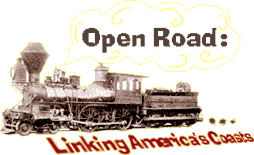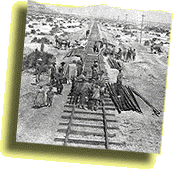
Last year 21 million passengers road Amtrak trains 5 billion
miles. It's easy to take America's labyrinth of rail tracks for
granted. But the story of connecting our nation by rail is an epic
being celebrated this coming week at a place called Promontory, Utah.
Hal Cannon of the Open Road takes us back to May 10, 1869 when
dignitaries and railroad workers met here to celebrate the completion of
the transcontinental railroad.
The Golden Spike: Linking America's Coasts
by Hal Cannon for the Open Road
 Tourists look startled as this behemoth locomotive pulls out of the
engine house at the Golden Spike National Historic Site as it does every
day, all summer long. I stand high in the cockpit of the Jupiter, an
exact replica of the original engine that first sent a plume of steam up
here a hundred-thirty years ago.
Tourists look startled as this behemoth locomotive pulls out of the
engine house at the Golden Spike National Historic Site as it does every
day, all summer long. I stand high in the cockpit of the Jupiter, an
exact replica of the original engine that first sent a plume of steam up
here a hundred-thirty years ago.
Engineer Bob Dowtey looks like a nineteenth century railroad man,
sporting striped overalls, a matching cap and a prodigious white
mustache. He fires her up, as steam pushes this cast iron dinosaur into
the morning sunlight.
Bob Dowtey: "The steam loco was the only machine that man ever invented
that sort of had a heart. They throb, they're almost alive. There's a
vitality to a steam locomotive that's lacking in a diesel and even more
so in an electric locomotive. They're really bad as far as I'm
concerned."
Pride swells as Dowtey tells me about his long-term love affair
with the Jupiter. He helped build her 20 years ago and he's runs her
ever since, keeping the brass bell polished, every fitting greased and
all the gauges and levers in tip-top shape. We're chugging down the
track towards the exact spot where, over a century ago, the rail was
joined, linking the continent forever.
Hal: "So what do you have, a mile and a half of track."
Bob: "Yeah."
Hal: "Do you ever wish it just went?"
Bob: "Of course."
Hal: "That must be the great frustration."
Bob: "Especially if you've run trains on a railroad where you've got miles to go.
You get 'em working hard...They sound and work good...better for the engines. They're made to run."
 But in order to run they needed good track and in the 1860's that
was not so easy. In fact, it's incredible, the engineering, the Chinese
laborers it took to lay track over the sheer granite walls of the
Sierras, the range that separates Nevada and California.
But in order to run they needed good track and in the 1860's that
was not so easy. In fact, it's incredible, the engineering, the Chinese
laborers it took to lay track over the sheer granite walls of the
Sierras, the range that separates Nevada and California.
Bob: "The Chinese lost hundreds of men building the railroad across
the Sierras. They would lower them down in baskets to drill holes into
the face of the rock. Then they would tamp that hold with a charge of
black powder...and then they'd light the fuse and have to get hoisted up and out of the way before that charge went off...and there were times when they didn't make it."
In fact, often a days progress was measured in inches and lives lost.
In the end, 1775 miles of track were laid connecting Sacramento with St.
Louis and the east. This is the place they met and the echoes of their
cheers still linger."
 A small group of tourists and re-enactors greets the Jupiter and
its counterpart from the east, the 119, as they meet, nose to nose, just
as they did so many years ago. Men in tall hats and frock coats relive
the ceremony and a burly fellow drives that final golden spike.
A small group of tourists and re-enactors greets the Jupiter and
its counterpart from the east, the 119, as they meet, nose to nose, just
as they did so many years ago. Men in tall hats and frock coats relive
the ceremony and a burly fellow drives that final golden spike.
The joining of our nation by rail is arguably the most important
event in American travel. Consider this: the journey from coast to
coast was cut from 6 months...with 10 percent of travelers losing their
lives...to a 6 day and 22 minute trip.
From the Open Road, I'm Hal Cannon for the Savvy Traveler.





 Tourists look startled as this behemoth locomotive pulls out of the
engine house at the Golden Spike National Historic Site as it does every
day, all summer long. I stand high in the cockpit of the Jupiter, an
exact replica of the original engine that first sent a plume of steam up
here a hundred-thirty years ago.
Tourists look startled as this behemoth locomotive pulls out of the
engine house at the Golden Spike National Historic Site as it does every
day, all summer long. I stand high in the cockpit of the Jupiter, an
exact replica of the original engine that first sent a plume of steam up
here a hundred-thirty years ago.
 But in order to run they needed good track and in the 1860's that
was not so easy. In fact, it's incredible, the engineering, the Chinese
laborers it took to lay track over the sheer granite walls of the
Sierras, the range that separates Nevada and California.
But in order to run they needed good track and in the 1860's that
was not so easy. In fact, it's incredible, the engineering, the Chinese
laborers it took to lay track over the sheer granite walls of the
Sierras, the range that separates Nevada and California.
 A small group of tourists and re-enactors greets the Jupiter and
its counterpart from the east, the 119, as they meet, nose to nose, just
as they did so many years ago. Men in tall hats and frock coats relive
the ceremony and a burly fellow drives that final golden spike.
A small group of tourists and re-enactors greets the Jupiter and
its counterpart from the east, the 119, as they meet, nose to nose, just
as they did so many years ago. Men in tall hats and frock coats relive
the ceremony and a burly fellow drives that final golden spike.